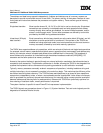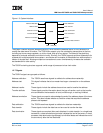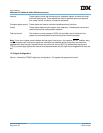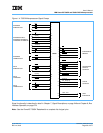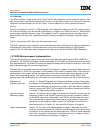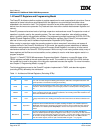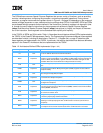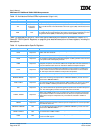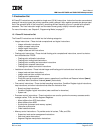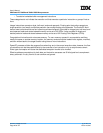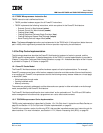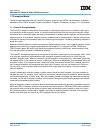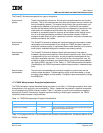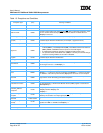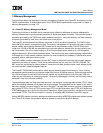
User’s Manual
IBM PowerPC 750GX and 750GL RISC Microprocessor
PowerPC 750GX Overview
Page 44 of 377
gx_01.fm.(1.2)
March 27,2006
Table 1-3 describes the SPRs in 750GX that are not defined by the PowerPC Architecture. Section 2.1.2,
PowerPC 750GX-Specific Registers, on page 64 gives detailed descriptions of these registers, including bit
descriptions.
.
SPRG0–SPRG3 Supervisor The general-purpose SPRs (SPRG0–SPRG3) are provided for operating system use.
TB
User: read
Supervisor:
read/write
The Time Base Register (TB) is a 64-bit register that maintains the time and date vari-
able. The TB consists of two 32-bit fields—time-base upper (TBU) and time-base lower
(TBL).
XER User
The Integer Exception Register (XER) contains the summary overflow bit, integer carry
bit, overflow bit, and a field specifying the number of bytes to be transferred by a Load
String Word Indexed (lswx) or Store String Word Indexed (stswx) instruction.
Table 1-3. Implementation-Specific Registers
Register Level Function
HID0 Supervisor
The Hardware-Implementation-Dependent Register 0 (HID0) provides checkstop
enables and other functions.
HID1 Supervisor The Hardware-Implementation-Dependent Register 1 (HID1) controls the dual PLLs.
HID2 Supervisor
The Hardware-Implementation-Dependent Register 2 (HID2) provides control and sta-
tus of special cache-related parity functions.
IABR Supervisor
The Instruction Address Breakpoint Register (IABR) supports instruction address
breakpoint exceptions. It can hold an address to compare with instruction addresses in
the IQ. An address match causes an instruction address breakpoint exception.
ICTC Supervisor
The Instruction Cache-Throttling Control Register (ICTC) has bits for controlling the
interval at which instructions are fetched into the instruction buffer in the instruction
unit. This helps control the 750GX’s overall junction temperature.
L2CR Supervisor The L2 Cache Control Register (L2CR) is used to configure and operate the L2 cache.
MMCR0–MMCR1 Supervisor
The Monitor Mode Control Registers (MMCR0–MMCR1) are used to enable various
performance monitoring interrupt functions. UMMCR0–UMMCR1 provide user-level
read access to MMCR0–MMCR1.
PMC1–PMC4 Supervisor
The Performance-Monitor Counter Registers (PMC1–PMC4) are used to count speci-
fied events. UPMC1–UPMC4 provide user-level read access to these registers.
SIA Supervisor
The Sampled Instruction Address Register (SIA) holds the EA of an instruction execut-
ing at or around the time the processor signals the performance-monitor interrupt con-
dition. The USIA register provides user-level read access to the SIA.
THRM1, THRM2 Supervisor
THRM1 and THRM2 provide a way to compare the junction temperature against two
user-provided thresholds. The thermal assist unit (TAU) can be operated so that the
thermal sensor output is compared to only one threshold, selected in THRM1 or
THRM2.
THRM3 Supervisor THRM3 is used to enable the TAU and to control the output sample time.
THRM4 Supervisor
THRM4 provides the temperature offset to junction temperature for accurate operation
of the thermal assist unit.
UMMCR0–UMMCR1 User
The User Monitor Mode Control Registers (UMMCR0–UMMCR1) provide user-level
read access to MMCR0–MMCR1.
UPMC1–UPMC4 User
The User Performance-Monitor Counter Registers (UPMC1–UPMC4) provide user-
level read access to PMC1–PMC4.
USIA User
The User Sampled Instruction Address Register (USIA) provides user-level read
access to the SIA register.
Table 1-2. Architecture-Defined SPRs Implemented (Page 2 of 2)
Register Level Function



